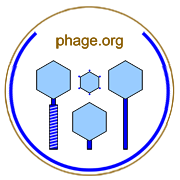

Likelihood of virion irreversible adsorption given collision between virion and target bacterium.
The term, adsorption affinity, may be preferable.
This is the concept supplied by the term, f, such as found in Stent (1963), 90: "Phage adsorption can then be treated as the
Diffusion of small virus particles toward large, essentially stationary bacteria, to which the phages become fixed at a fraction f of all collisions." To my knowledge, however, Stent did not apply the term "adsorption efficiency" to this concept but did indicate that the actual, measured adsorption for a phage should be equal to whatever the theoretically determined maximal possible adsorption rate given the physical description of a system divided by this value, f, which is equivalent to the concept of efficiency of adsorption (that is, k = ktheoretical × f, though note that he defined ktheoretical instead as k/f, i.e., ktheoretical = k/f, where k is the measured phage adsorption constant). Implicitly this appears to be the meaning employed by Friedman and Cowles (1953), Sanders and Klaenhammer (1984), McKay and Baldwin (1984), Vlegels et al. (1988), and Breitbart et al. (2005). See also Lieb (1953), Givan et al. (1982), Lodics and Steenson (1993), Li et al. (1998), Bollback and Huelsenbeck (2001), and Guglielmotti et al. (2006).
In terms of experiments, adsorption efficiency, per the above definition, should be seen as a description of something that can impact phage adsorption rates even when virion diffusion rates, bacterial size, and bacterial mobility all are held constant. Adsorption efficiency thus can vary particularly because of differences in adsorption cofactor prevalence within adsorption media, differences in phage receptor densities on bacterial surfaces, due to molecular differences in phage receptors, or resulting from barriers (e.g., EPS or capsules) to phage contact with receptors. That is, holding rates of phage collision with bacteria constant, adsorption efficiency is a description of variance in the likelihood of irreversible phage adsorption.
Aparicio et al. (1990) employ the term to describe the degree of adsorption observed relative to a control that supports greater levels of adsorption. Adsorption efficiency, perhaps not surprisingly, has also been used as a more general, perhaps somewhat poorly defined term. For example, from Larbi et al., 1992 (p. 352), "In all cases, the adsorption rate was > 96%. The temperature-dependent plaque phenotype was therefore independent of the phage adsorption efficiency of the bacterial cells." See too Murray and Jackson (1992). Consistent with this usage, a broader definition for adsorption efficiency could include not just likelihood of adsorption given collision but also likelihood of collision as well. With this definition, if phage diffusion rates are held constant, then adsorption efficiency and the phage adsorption constant are similar if not identical concepts (Eisenstark, 1967; Ashelford et al., 1999). See also Hennes and Simon (1995).
Alternatively, Storms et al. define adsorption efficiency as "The adsorption efficiency is the fraction of phage that adsorbs irreversibly to the host." Their definition and that presented above are equivalent in that the occurrence of phage-bacterial collision is implicit to the Storms et al. definition. The Storms et al. definition is narrower, however, in that it also is implicitly suggestive that the failure to irreversibly adsorb is a relatively long-term property of the virion particle rather than a function solely of the dynamics of individual phage-host interactions. That is, Storms et al. effectively are rebranding the concept of residual fraction as that phage population defined by one minus adsorption efficiency. Preissner et al. (1988) appear to use "adsorption efficiency" similarly. It is important to note, however, that when adsorption is measured using end-point determinations, rather than kinetically, then it can be difficult to distinguish between adsorption "inefficiency" as defined prior to this paragraph or instead in terms of a residual fraction. That is, end-point adsorption determinations cannot distinguish between incomplete adsorption that has a occurred due to slow but consistent rates of adsorption versus the existence of two phage populations, one that adsorbs relatively rapidly and one that does not.
Coetzee et al. (1986) by contrast use "adsorption efficiency" perhaps similarly to the concept of capacity, though in terms of phage adsorption to detached pili rather than to whole bacteria.
Note that the literature search employed to generate this entry was not exhaustive and indeed not only were a number of publications in which "adsorption efficiency" was used not cited, due to ambiguity in meaning, but in fact a substantial number of publications using this term were not examined by the author.
For more on this topic, see Wikipedia, Google, and PubMed. Contact web master. Return to terms.